Pruning hydrangea
Content:
For many garden and flower crops, pruning is a mandatory care measure, thanks to which you can not only maintain the health of the plant, but also return it to its second youth, extend the flowering period. Hydrangea in this case is no exception to the rule, and hydrangea pruning is a mandatory care procedure.
Hydrangea is called a majestic and royal flower, which is loved by many flower growers and gardeners. The name literally translates from Latin as "a flower with water". And this is due to the fact that hydrangea is in fact the very flower that incredibly loves moisture and water. Due to it, it is nourished, it becomes even more decorative and attractive.
Pruning hydrangeas as an integral part of grooming
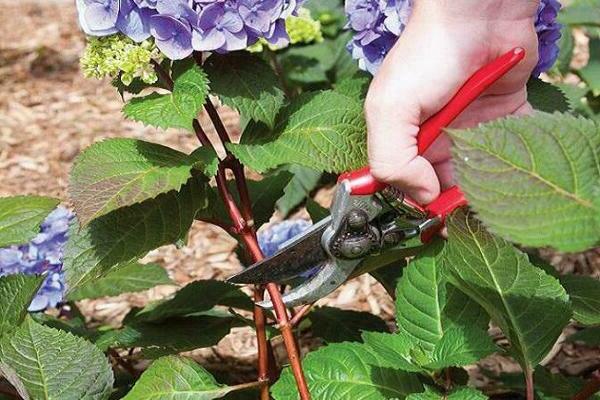
In general, hydrangea is unpretentious and not capricious at all, it does not require special attention to itself. Although it responds well to a variety of care procedures that a gardener can arrange for her.
At the same time, throughout the summer, autumn, until the onset of severe frosts, hydrangea can delight the gardener with its appearance, incredible flowering, which at some moments seems to be incessant, endless.
The most important thing in caring for hydrangeas is on time. to water her and feedusing organic and mineral fertilizers for this. But also in order for the inflorescences to be very lush, it is necessary, among other things, prune hydrangea.
Usually, hydrangea pruning occurs either in the fall or in the spring. Much depends on the weather conditions that form in the area. And also on which variety the hydrangeas belong to, which the gardener decided to grow on his site.
In this article, we will dwell in more detail on what types of hydrangeas exist today, what are the main factors for cutting flowers. We will also talk about the key conditions for pruning in the fall and spring, as this is very important. After all, any procedures and manipulations should be regulated by some rules, and the main ones are agrotechnical ones.
The article will be useful and interesting not only for gardeners who are just starting their activities, but also for gardeners who already have experience in growing hydrangea and caring for it, but at the same time are in constant search of completely new manipulations and opportunities in order to maximize the potential of this flower in all its decorative beauty.
Pruning hydrangea species
Hydrangea is not a separate flower variety. Today, there are several dozen of the most different types of hydrangeas at once. And gardeners know about eighty, which, you see, is a pretty impressive number. But still the most famous and widespread types of hydrangeas are only a few. Among them, we highlight such as:
Tree hydrangea
This is a special decorative bush that has a very lush and rather spectacular inflorescence. The flowering duration is quite impressive. It usually begins around July and ends in October, with the arrival of frost and cold snap.
It is worth noting that the tree hydrangea is a rather unpretentious and stable shrub that can withstand even very severe frosts and temperature changes, which are sharp in some regions.The bush adapts well and shows excellent growth in partial shade and in sunny places.
New inflorescences usually form on shoots that date from the current year. In general, tree hydrangeas are unpretentious and very attractive plants, so in no case should they be written off.
The most popular varieties of tree hydrangea are Annabelle, Pink Annabelle. They have an incredibly delicate and attractive appearance, if the gardener properly cares for the plants, he can get a long and attractive flowering with delicate pink fragrant flowers, as well as snow-white inflorescences with an incredibly attractive aroma.
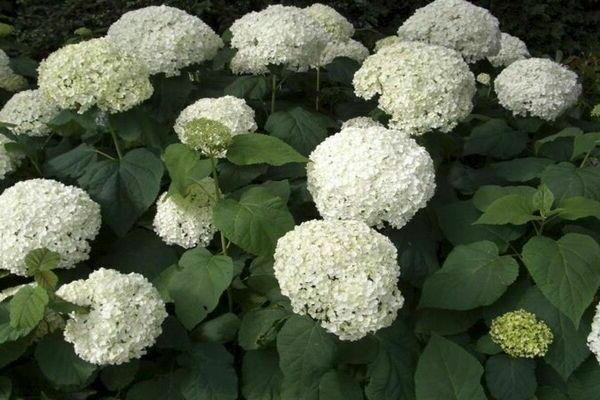
Treelike hydrangea Annabelle cultivar: Photo of the cultivar
Panicle hydrangea
This is the plant that most of all amazes gardeners with its incredibly chic inflorescences, which in shape most resemble a cone. In this case, the inflorescences can be either small or large. If these are small inflorescences, then they belong to bisexual flowers, but larger inflorescences are sterile.
When the panicle hydrangea blooms, it can change its color, resembling a chameleon. At first, it can be snow-white, then it becomes a delicate pink color, and then it becomes completely bright, fuchsia. This can affect any grower. Indeed, in reality, such a bloom looks great on a personal plot, or in a flower bed, in a composition.
The most popular varieties of panicle hydrangea are such as Pinky Winky, Bobo or Diamond Rouge. They differ from each other in shades, the duration of flowering, but in general the bushes are extensive and chic.
The only thing these paniculate hydrangeas require is pruning the hydrangea and shaping the crown, otherwise the plant will look slightly sloppy and neglected. This is certainly not at all what the gardener is striving for in search of new varieties that will decorate his site, and not make it neglected and unattractive.
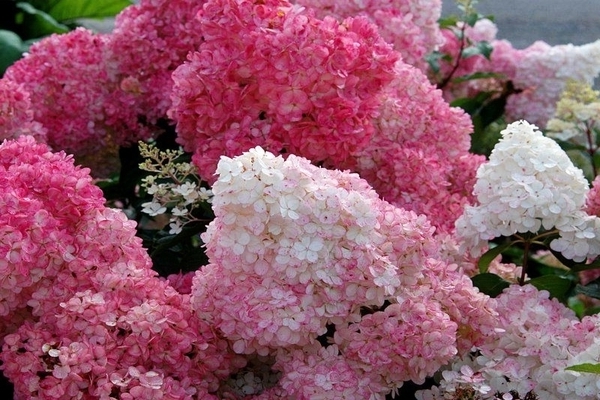
Panicle hydrangea variety Samarskaya Lydia: Photo of the variety
Large-leaved hydrangeas
These plants are incredibly attractive, which can also change the color of the inflorescences very actively. For example, as it blooms, an initially pink flower can turn blue, and red flowers transform and turn purple. This happens due to the fact that the level of acidity in the soil can either increase or decrease, which immediately affects the external characteristics of the plant itself.
At the same time, if this is a large-leaved hydrangea, then its snow-white inflorescences do not at all lend themselves to staining or changing colors. Inflorescences are mainly formed on shoots that began their development last season.
For this reason, if the gardener decides to prune, or the shoots have suffered as a result of frost, then there may not be flowering at all. It is best to plan pruning for the autumn period, and by winter it is imperative to cover the bush to protect it from frost and sudden temperature changes.
Therefore, many experienced gardeners and flower growers are well aware that the large-leaved type of hydrangea is distinguished by its whimsicality and capriciousness. So it is worthwhile to objectively assess your strengths and capabilities several times and understand whether it is worth taking this particular species for planting at all. Or, it would be best to abstain and grow other specified types of hydrangeas on your site.
It is also worth providing large-leaved bushes with thorough care and support in order to get an excellent result. Otherwise, it may turn out to be completely different from what the gardener himself originally expected, which will lead to disappointment in all other types of hydrangea.
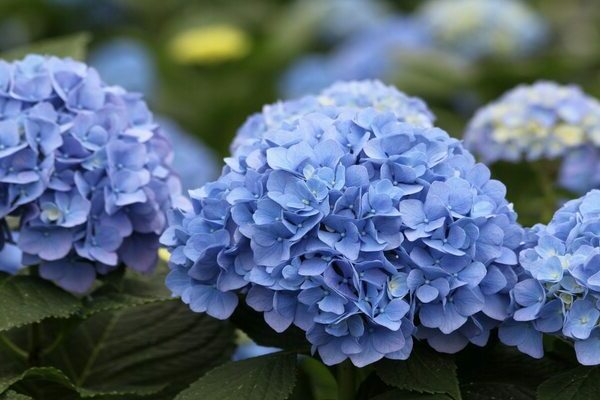
Large-leaved hydrangea cultivar Blauer: Photo of the cultivar
There are several more types of hydrangeas, but at the same time in modern floriculture they are not found as often as the species that we have listed just above.These types include oak-leaved, serrate, petiolate hydrangeas, as well as the so-called sargent.
Oak-leaved hydrangea
This is the species that most resembles the panicle hydrangea due to its inflorescence. In addition, this flower exudes a light, slightly perceptible, but incredibly attractive aroma, which is one of the main highlights of this species.
The leaves are more like oak leaves, and this is what caused the species to get this name. The leaves are very pleasant to the touch, more like a velvet attractive surface.
There is also another feature of oak-leaved hydrangeas, which is that the leaves can change their color depending on the season. For example, in the summer, the leaves are juicy, bright, green, but when autumn comes, the leaves become burgundy, almost crimson.
This appearance looks very impressive on the garden plot, which gives the plant an even more decorative character. For this, hydrangea is so famous today among modern gardeners, florists, gardeners and designers who use it to decorate landscapes.
But unfortunately it cannot be said that this type of hydrangea is too common today in gardening. However, it has a huge number of advantages that many gardeners are not aware of at all, which is certainly quite sad.
Note that oak-leaved hydrangeas are excellent flowers in order to be as frost-resistant as possible and not be attacked by pests and bacteria, which often harm the plants of this family.
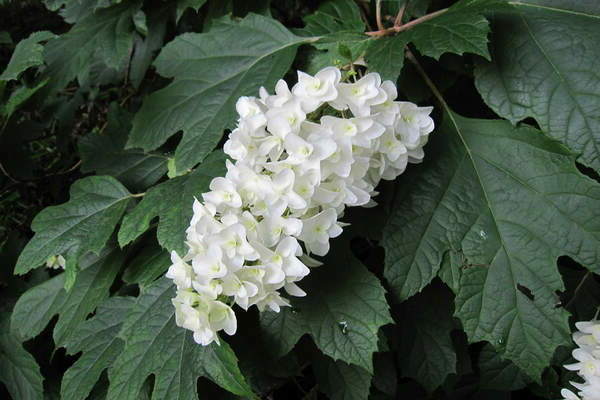
Oak-leaved hydrangea variety Harmony: Photo of the variety
Serrated hydrangea
In the same way as the large-leaved species, it can very actively change its color. And an important role here is played by the condition of the soil, its composition and the level of acidity. The colors most often vary from delicate blue to lilac shades.
At the same time, this species is quite unstable, therefore, before leaving it for the winter period, care must be taken to cover the hydrangea, to protect it from sharp frosts and sudden changes in temperature. If you do not do this, then there is a possibility that next year this species will refuse to bloom, and the bush itself will die altogether.
Petiolate hydrangea
Otherwise, gardeners call it a garden vine. This hydrangea is very tall. Sometimes its height is about 20 meters, which, of course, becomes an incredible indicator. One way or another, this type is also not very common in gardening, although it attracts some flower growers with its external characteristics.
Very whimsical to care for. The trunk must be constantly inspected, monitored in its general condition, sometimes trimmed so that no damage or other deformations occur that can lead to the death of this type of hydrangea.
The last species, which is not so often found in floriculture, although popular among the people, is sargent... The plant produces incredibly attractive pale purple flowers that are distinguished by their tenderness. The leaves are rather large. But as for leaving, then by the winter the hydrangea must be covered. Otherwise, there is a great risk that the plant will freeze, and in the future it simply will not give any flowering.
Correct hydrangea pruning and why you need it
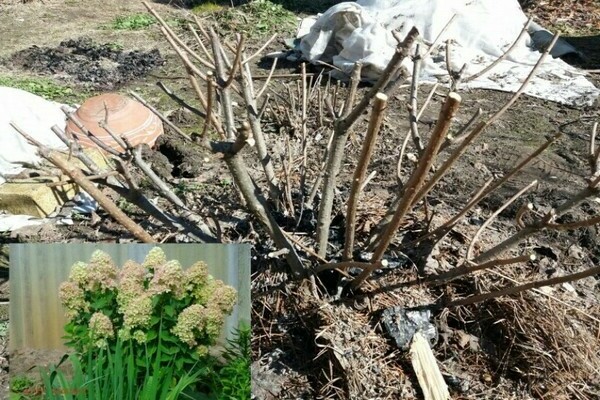
Hydrangea is a flower that distinguishes itself from all others in that it blooms incredibly and attractively, and this bloom can be seen even from afar. But, of course, such an effect can be achieved only if the gardener takes all measures to care for the plant, and also gives it watering, top dressing, and timely care measures.
One of them is and pruning... If you do not carry it out on time, then the hydrangea will look more like an unkempt and neglected shrub, which can grow very much and lose its decorative features.
The inflorescences will also become very small, the flowering itself will not be as abundant as it could be if the gardener did not treat the care measures so dismissively and did not skip them.
But it is thanks to pruning that the inflorescences can be very lush and large. In this case, you should pay attention to several tasks that the gardener sets himself when pruning hydrangeas:
- rejuvenation plant;
- the formation of a healthy, attractive and strong crown;
- pruning can be carried out in order for a more powerful growth of completely new shoots of the plant to occur, on which attractive, healthy and strong inflorescences will also form;
- thinning the crown to avoid excessive thickening. If the crown thickens, then this can lead not only to the untidy appearance of the plant, but also to the fact that in the future the plant will simply start to hurt. Since the dense crown is an excellent environment for the development of bacteria and harmful microorganisms
- removal of branches that managed to freeze, fade, or were damaged under certain circumstances, and now need to be removed in a timely manner. Otherwise, due to these branches, not only the appearance of the plants will be lost, but in general, too many vitamins, minerals and forces, nutrients are spent on nourishing these branches. Although the gardener will not achieve absolutely any sense from them. In general, pruning always plays a significant role and can perform many functions that make the plant feel alive, adaptable, healthy.
Pruning hydrangeas in autumn and spring: timing
Any gardener, both experienced and of course beginners, are wondering when is the best time to prune a hydrangea, and in which of the periods it will respond best to pruning - in the autumn or in the spring.
As a rule, if we are talking about basic cropping, then it must be carried out in the early spring period, when the snow has already melted, but the sap flow in the plant system has not yet begun. Thus, the main pruning is planned around the end of March.
If it is large-leaved hydrangea and a similar appearance, then it does not need to be cut in the spring. Since the new inflorescences of this plant are tied and grow from the upper buds, which are not pruned in this species.
In this case, it is possible to carry out renovation and sanitary pruning... To do this, it is best to consult with more experienced gardeners or get acquainted with some videos on how to properly carry out a renewing hydrangea pruning and not do any harm to it. Since, nevertheless, despite its resistance, this plant can react quite vividly to any mechanical manipulations and interventions on the part of the gardener himself. Moreover, this reaction may not always be favorable, and the plant may even refuse to give inflorescences after pruning.
If we are talking about pruning species such as treelike or panicle hydrangea, then it can be carried out in the autumn and spring periods. Everything here will depend solely on the capabilities and desires of the gardener himself. And also on the state of this plant.
In addition, weather and climatic conditions are taken into account, which can also affect the general condition of the plant. And sometimes it is best to endure the pruning or skip it altogether under some circumstances that are also significant enough.
If this autumn pruning hydrangea, then the gardener usually has to remove all old inflorescences, branches that have been damaged, broken or withered, as well as shoots that grow inside the crown of the hydrangea and thicken it too much. That also does not always have a positive effect on the general condition of this plant.
Of course, such manipulations and pruning are always special individual aspects, so the gardener should take very serious care to carry out pruning and at the same time do not damage the general condition of the plant at all.
Of course, as we have already noted, both its appearance and the internal general health of this plant will depend on how correctly the hydrangea was pruned. After pruning, the inflorescences can become larger, even more attractive and decorative. Again, in order to achieve this effect, it is recommended to adhere to some rules, which we will list just now.
Pruning hydrangea: rules, subtleties, notes

These rules include the following:
- hydrangea bushes must be cut off only with a very sharp secateurs, which were previously treated with disinfectants and disinfectants. This is very important in order not to cause further damage or injury to the plant during the pruning process. And also so that bacteria and infections that will provoke fungi and other very dangerous diseases for the plant do not enter through the cut parts.
- In no case should the branches of hydrangea be cut off just like that, since this largely injures the plant, makes it weak, vulnerable. And as a result, there is a high probability that the bush will simply refuse future flowering.
- last year's inflorescences, damaged or dried branches are recommended only in favorable weather. But still it is worth remembering that in spring pruning is carried out until the moment when sap flow begins in the internal system of the plant. Thus, spring pruning may not always be done under favorable conditions. And so the gardener can tolerate it. But this does not mean at all that it will be possible to neglect some techniques and just careful handling of plants. We also note that these rules must be adhered to in March and October, since at this time the hydrangea is sleeping, is at rest. Therefore, she can react more calmly to pruning. This means that after such manipulations, the plant as a whole will feel comfortable, which means that the hydrangea will be cut more safely.
- in no case should you just leave hemp and cuts. Otherwise, the plant can become infected with bacteria and viruses, microorganisms that provoke diseases that are dangerous to the flower. After pruning, it is recommended to treat the plots with garden varnish or use its substitutes. But without fail, these parts of the plant must be processed. There should not be any sections that will not be protected from external influences.
If there are very thick branches on the bush, then you should not take too much risk. You should immediately use a hacksaw to make a cut. It should also be borne in mind that the edges of the saw cut must be neat and even. And after pruning, the saw cut itself should be treated with garden varnish or its substitutes.
The cut should be done not even, but slightly obliquely. In this case, the distance from the kidneys should vary from two to three centimeters, no more, but no less.If, in the process of pruning, the gardener inflicted any more damage on the bush, they should also be immediately treated with pitch and substitutes. Otherwise, very dangerous bacteria can enter the plant through these wounds. And there will definitely not be any sense from them, only harm and risks that the plant will generally wither and die in the very near future.
If the bush has managed to grow to a fairly large size, then it is better not to cut off all the branches at once, but to do it in stages, over two years. Otherwise, hydrangea will simply die from such active pruning, and the gardener will not have time to take any measures in order to preserve the life of this plant.
If the gardener observes all these rules, carries out either spring or autumn pruning in compliance with all agrotechnical requirements, then he will be able to enjoy large and very abundant hydrangea flowering in the future, and the bush itself at rest will have an incredibly attractive appearance.
It is for this reason that we pay so much attention with regard to maintenance and agrotechnical measures. After all, otherwise the plant will simply wither away and will not be able to realize its full potential, which the gardener is guided by when choosing ornamental plantings for the site.
In the first two to three years, the crown should be cut in order to correctly form it in a very young plant. To do this, you should also take into account some of the specific features that almost every hydrangea belonging to a particular family possesses. So, for example, if this is a large-leaved type of hydrangea, then it is necessary to cut off only those inflorescences that have already bloomed, and from which there will no longer be any benefit, but the new flowering shoots must be left in place, without subjecting them to any removal, otherwise it will lead to the fact that the hydrangea, in principle, will stop flowering, which, of course, will play a very negative role in the development of this flower and in the fact that in the future it can fulfill the previously prescribed decorative features and characteristics.
If the hydrangea belongs to the paniculate species, then the gardener can easily and simply, calmly form it in the form of a tree. But here it is worth removing not only weak branches, which practically do not show any signs of life, but also shoots that grow inside the crown and thicken it too much. It shortens strong shoots to the gardener, while removing from one to two buds.
This is due to the fact that the stronger the hydrangea branches, the more buds you can leave on it. So the gardener should take into account this significant circumstance. But still, if the goal remains one - to form a correct and attractive bush, then in this case, when planting a hydrangea, it can be slightly deepened.
After some time, the gardener will notice that more and more shoots appear, which in the future will give all the necessary flowering to this bush.
Pruning hydrangeas of different ages
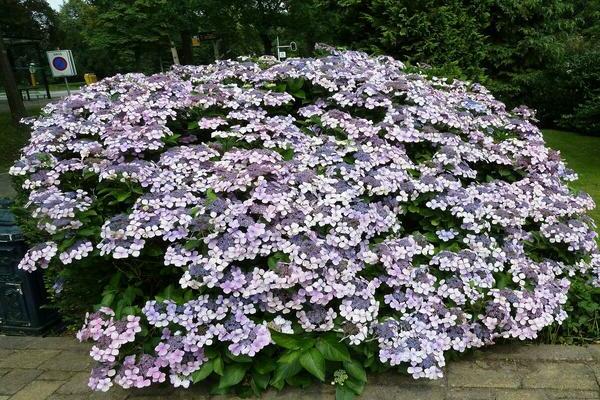
Young plants - this is a separate story, since they also need pruning. In the first year, it is recommended to shorten some shoots. At the same time, this should be done in moderation, little by little. It is also necessary to remove branches that have been damaged, infected with some kind of disease, or are simply frozen, and therefore need the gardener to remove them from the bush.
Also, pruning of hydrangeas is also carried out so that the plant normally adapts to new conditions, and the new root mass grows with even greater force. Indeed, how healthy the bush will be largely depends on the general condition and security of the root system. And how much the gardener will be able to achieve his goal - to get an excellent, healthy and very decorative hydrangea bush, while not wasting a huge amount of time, material and physical resources for this.
In the second season, the branches of young bushes are also shortened and three or four healthy and strong buds are left.Also in the second year, the skeletal part of the plant is formed, which will become the basis in the future for the full growth of the bushes.
When hydrangeas become adults, then the level of their flowering can be significantly reduced. In this case, the bushes become smaller, the inflorescences become not at all as spectacular and attractive as they were quite recently, and they certainly cease to please the gardener's eye. At the same time, thanks to pruning, you can effectively cope with this problem. But even here you should adhere to some rules, since, nevertheless, precautions and attentiveness can really play an important role and preserve the general condition of the plants.
Among the rules are such as:
- old shoots that have remained on the hydrangea from last year should be removed. You can leave no more than three buds on them. In this place, after a while, new shoots will grow, which will give a healthier and more powerful flowering. So do not be particularly afraid that after pruning the bush will generally lose its capabilities.
- dry branches and those that have had time to freeze too much are also removed. Because of them, not only the general appearance of the plant is lost, but also, in principle, the general condition of the hydrangea becomes even worse.
- in order for the plant to be evenly under the sun, and it has enough lighting to be completely protected, it is necessary to trim all branches and shoots that grow inside the crown and can lead to its active thickening. Thanks to this, the gardener also avoids the formation of a favorable environment for infections and bacteria, the vital activity of some microorganisms that settle inside the dense crown and can cause a variety of fungal and other types of diseases.
- many old shoots that originally began their growth from the roots of the hydrangea are removed during pruning. They can be very carefully removed to the very base, and the plant will be very grateful to the gardener for this.
If the bushes are really old, have suffered from diseases or other external influences and factors, then they can be effectively rejuvenated with the help of pruning. For this, the gardener carries out the so-called radical pruning.
The plant is pruned, leaving only the stump. All old shoots and large branches are removed. Moreover, this should be done with a hacksaw, so as not to cut off the branches and not apply any other mechanical effects to them. Also, the sections are then processed with garden varnish so that diseases do not form in their place.
It is also worth remembering that all pruning tools must always be decontaminated and disinfected so as not to introduce bacteria into the cut sites.
Types of trim
Radical pruning, which is carried out in relation to, for example, a large-leaved hydrangea, can return the plant to its youth and extremely attractive appearance. But do not forget that pruning has some disadvantages.
For example, after it, the plant may not give absolutely any flowering for a year. This does not mean that it got sick, or that this effect will always last. This means that hydrangeas need to accumulate some nutrients and strength for the next flowering, which in fact is capable of capturing the imagination of any grower, even with experience and colossal vast ideas about the possibilities of these particular plants.
Sanitary pruning Is another type of pruning that is used by experienced gardeners. It is intended to heal the plant and allow it to acquire its former decorative effect, and in some cases even enhance it, if this is required, of course.
First of all, the gardener removes all diseased branches that have dried up, as well as damaged branches that will no longer have those former opportunities for development and subsequent flowering.Further, the gardener is required to very carefully examine the shrub. Since there are cases that in addition to damaged and dried branches, you can also remove those that have no value for this plant.
For example, these are initially weak branches or branches that grow inside the bush, dividing the crown into an impermissibly thickened and completely unattractive one. In fact, sanitary pruning makes the appearance of the plant even fresher and more special. And in the future, during flowering, the gardener will be able to get a huge amount of positive emotions from everything that happens.
Of course, in order for pruning to take place favorably and end with a successful outcome, all these rules should be observed and the recommendations set out should be followed. Do not forget that all instruments must be perfectly sharpened and treated with disinfecting substances that give a disinfecting effect.
Otherwise, there is a great risk that pruning hydrangeas, even if done correctly, will cause great harm to the plant, and it will then die. As soon as temperature stable warm days come, the tools are very carefully prepared, the plants themselves are also almost ready for pruning, which is carried out before the onset of sap flow.
The general condition of the plant, as well as how it will grow and develop in the future, please the gardener with its external decorative characteristics, large and varied flowering, largely depends on the care and responsible attitude of the gardener himself.
Pruning hydrangeas - features of pruning different types
In fact, of all types of hydrangeas, only large-leaved can be considered an absolutely moody look. She needs careful shelter for the winter, so that the bush does not freeze and die. As for the arboreal or paniculate hydrangea species, they winter quite calmly, they do not need additional protection. Although in some regions, gardeners still recommend doing it so that the bushes feel as comfortable as possible.
Therefore, if the gardener is not sure that in the spring he will be able to cut a large-leaved hydrangea on time and competently, then it is best to wait for the moment when the buds begin to live, they will noticeably swell. It is at this time that it will be best seen which branches have survived the winter period perfectly, and which ones at this time are sick or frozen, and they should be removed in order to protect the entire plant as a whole.
If the gardener wants to make a shelter for the hydrangea, then he pushes it to the ground, and sometimes, if the bush does not give in to this, it can even be tied to several specially installed pegs. Therefore, before the gardener starts the pruning process, he very carefully straightens the plant and inspects it. Only then does it cut off the branches that are completely unsuitable for the next growth.
It is worth remembering that if the gardener shortened the shoots too much or cut them off altogether, then the plant may feel such discomfort and not give any flowering at all. So the rules and recommendations are what is important and extremely necessary for every gardener when pruning hydrangeas.
Some are wondering how to prune tree hydrangea, both in spring and autumn. So, for example, during autumn pruning, the gardener immediately sees the state of all the shoots that the plant gave. Therefore, it is best to first cut off exactly those inflorescences that have already faded in the current season.
This is also necessary so that the hydrangea does not tilt and break under the weight of snow drifts. The next year, powerful and very strong young shoots will already form on these bushes, which will form the bone basis for the hydrangea.
Also, tree hydrangea can be pruned in the spring.To do this, the shoots are shortened by a third, two to three buds are left on each, no more. It is also worth removing those branches that are rather painful and weak, since there is a high probability that they will remain so weak, and the plant will still give off some trace elements and energy in order to preserve their vital functions.
And here panicle hydrangea you can not trim at all. But at the same time, cone-shaped flowers may eventually lose their superiority and attractiveness, and the bush will become less decorative and too thick. Therefore, of course, it is best not to be lazy and start pruning the panicle hydrangea.
But this does not depend at all on what time of the year the pruning will be carried out - in spring or autumn. After all, the most important thing is to just do it, not to save time and energy on it. And then the bush will be grateful, it will show the gardener its lush flowering, which will begin in July and stop in October, with the onset of the very first serious frosts.
The shoots of the plant are cut so that at least two or three buds remain. You can also form a bush by removing all weak twigs and branches, which have a rather painful appearance.
When a gardener is pruning a hydrangea, he may have a sufficient number of cuttings left. In the future, he will be able to use them in order to propagate hydrangea. So you should not rush to clean the site, but you can get a brand new amazing hydrangea bush.
Hydrangea care after pruning
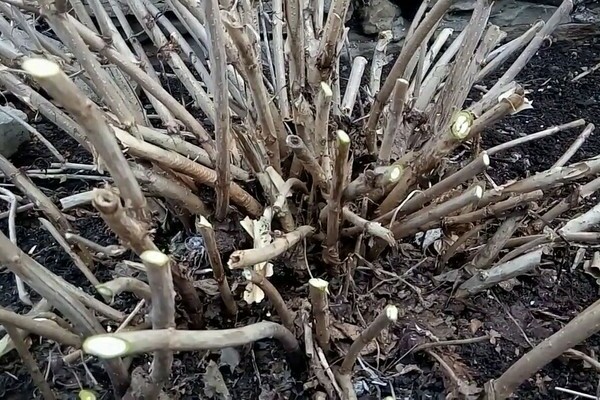
After the hydrangea has been pruned, it is worth taking care of the flower. Below we will present instructions for the care of a hydrangea after autumn pruning, because after that the bush should be prepared for wintering:
- all leaves from the bush are carefully plucked.
- around the bush it is worth making insulation from spruce branches.
- hydrangea branches are pressed to the ground and fixed.
- from above it is all sprinkled with peat, and then covered with spruce branches.
- agrofibre or a special agrotextile is laid on top (you can use thermal insulation materials), then a layer of film (polyethylene or more dense - plastic) is laid on top, the edges are pressed with stones or pegs for fixation.
At the same time, there is no need to cover paniculate or tree-like hydrangeas for the winter, since they quite calmly do without this procedure. But after spring pruning, the plant should be well fed (both with organic matter and mineral additives), mulch the soil, loosen it, and water it regularly, taking into account the weather conditions.
Ideally, urea and ammonium sulfate, ammonium nitrate or potassium permanganate can be used as fertilizers for hydrangeas. They contain all the important and necessary components, while the gardener should keep in mind that the instructions for the use of fertilizers are his most faithful friend, and adhering to it can bring the plant great benefits.

